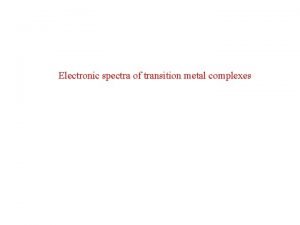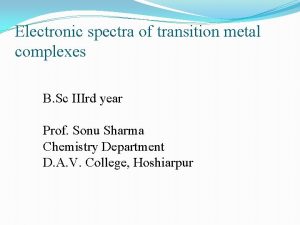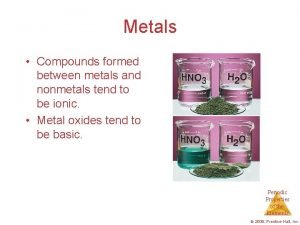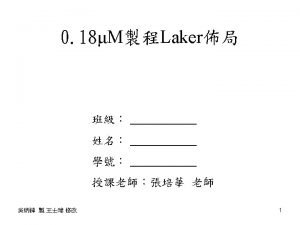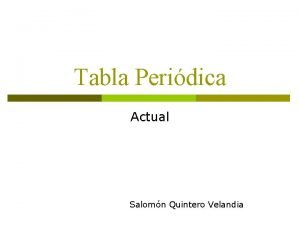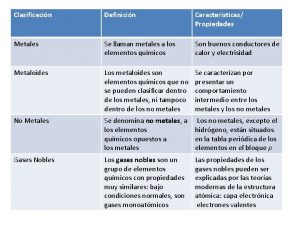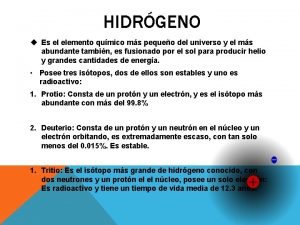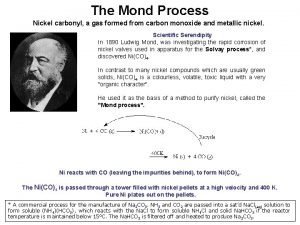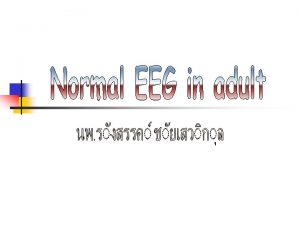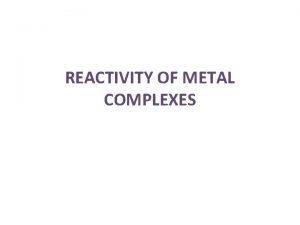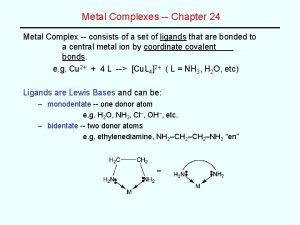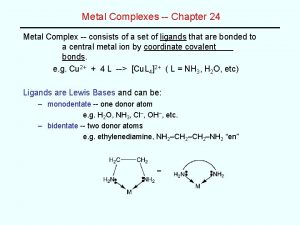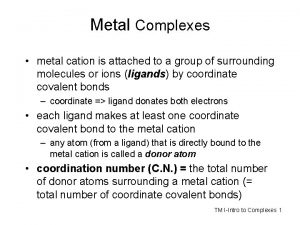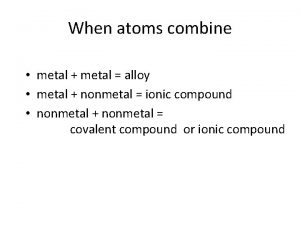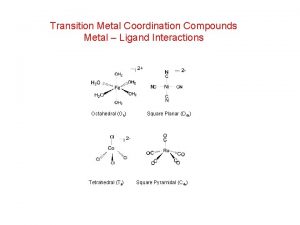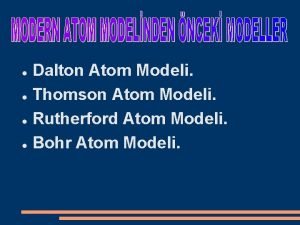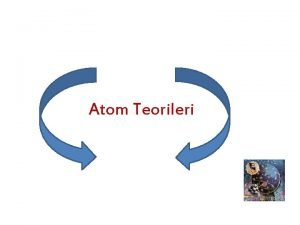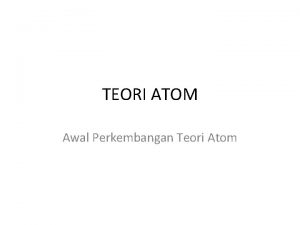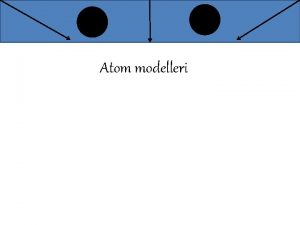Complexes Complexes Compounds in which a metal atom


![Structure 1. [Hexaammineplatinum(IV)] chloride [Pt(NH 3)6]Cl 4 central ion coordination number ligand complex cation Structure 1. [Hexaammineplatinum(IV)] chloride [Pt(NH 3)6]Cl 4 central ion coordination number ligand complex cation](https://slidetodoc.com/presentation_image_h2/9683a4af1273358f85277427c531d824/image-3.jpg)
![2. Potassium hexachloroplatinate(IV) K 2[Pt. Cl 6] central ion coordination number ligand complex anion 2. Potassium hexachloroplatinate(IV) K 2[Pt. Cl 6] central ion coordination number ligand complex anion](https://slidetodoc.com/presentation_image_h2/9683a4af1273358f85277427c531d824/image-4.jpg)
![3. Iron(O)pentacarbonyl [Fe(CO)5] central atom coordination number ligand complex molecule 3. Iron(O)pentacarbonyl [Fe(CO)5] central atom coordination number ligand complex molecule](https://slidetodoc.com/presentation_image_h2/9683a4af1273358f85277427c531d824/image-5.jpg)

![Complexes with various coordination numbers Coordination Complex number 2 [Ag(NH 3)2]+, [Cu. Cl 2]3 Complexes with various coordination numbers Coordination Complex number 2 [Ag(NH 3)2]+, [Cu. Cl 2]3](https://slidetodoc.com/presentation_image_h2/9683a4af1273358f85277427c531d824/image-7.jpg)






![Dissociation of complexes Conductance* Number of ions Number of chloride ions [Pt(NH 3)6]Cl 4 Dissociation of complexes Conductance* Number of ions Number of chloride ions [Pt(NH 3)6]Cl 4](https://slidetodoc.com/presentation_image_h2/9683a4af1273358f85277427c531d824/image-14.jpg)


![Cr. Cl 3·6 H 2 O [Cr(H 2 O)6]Cl 3 [Cr(H 2 O)4 Cl Cr. Cl 3·6 H 2 O [Cr(H 2 O)6]Cl 3 [Cr(H 2 O)4 Cl](https://slidetodoc.com/presentation_image_h2/9683a4af1273358f85277427c531d824/image-17.jpg)
![cis trans NH 3 Cl Co NH 3 Cl NH 3 [dichloro-tetraammine-cobalt(III)] ion cis trans NH 3 Cl Co NH 3 Cl NH 3 [dichloro-tetraammine-cobalt(III)] ion](https://slidetodoc.com/presentation_image_h2/9683a4af1273358f85277427c531d824/image-18.jpg)
![Cl Cl Cl en Cl Co Co en en [dichloro-bis(etylenediammine)cobalt(III)] ion en = etylenediammine Cl Cl Cl en Cl Co Co en en [dichloro-bis(etylenediammine)cobalt(III)] ion en = etylenediammine](https://slidetodoc.com/presentation_image_h2/9683a4af1273358f85277427c531d824/image-19.jpg)

- Slides: 20

Complexes

Complexes Compounds in which a metal atom or ion is surrounded by a number of oppositely charged ions or by neutral molecules. All possessing lone pairs of electrons which are available for donation to vacant orbitals of the metal atom or ion.
![Structure 1 HexaammineplatinumIV chloride PtNH 36Cl 4 central ion coordination number ligand complex cation Structure 1. [Hexaammineplatinum(IV)] chloride [Pt(NH 3)6]Cl 4 central ion coordination number ligand complex cation](https://slidetodoc.com/presentation_image_h2/9683a4af1273358f85277427c531d824/image-3.jpg)
Structure 1. [Hexaammineplatinum(IV)] chloride [Pt(NH 3)6]Cl 4 central ion coordination number ligand complex cation
![2 Potassium hexachloroplatinateIV K 2Pt Cl 6 central ion coordination number ligand complex anion 2. Potassium hexachloroplatinate(IV) K 2[Pt. Cl 6] central ion coordination number ligand complex anion](https://slidetodoc.com/presentation_image_h2/9683a4af1273358f85277427c531d824/image-4.jpg)
2. Potassium hexachloroplatinate(IV) K 2[Pt. Cl 6] central ion coordination number ligand complex anion
![3 IronOpentacarbonyl FeCO5 central atom coordination number ligand complex molecule 3. Iron(O)pentacarbonyl [Fe(CO)5] central atom coordination number ligand complex molecule](https://slidetodoc.com/presentation_image_h2/9683a4af1273358f85277427c531d824/image-5.jpg)
3. Iron(O)pentacarbonyl [Fe(CO)5] central atom coordination number ligand complex molecule

Central ions, atoms: Transition metals Alkaline earth metals Alkaline metals Coordination numbers: Number of ligands in the first coordination sphere
![Complexes with various coordination numbers Coordination Complex number 2 AgNH 32 Cu Cl 23 Complexes with various coordination numbers Coordination Complex number 2 [Ag(NH 3)2]+, [Cu. Cl 2]3](https://slidetodoc.com/presentation_image_h2/9683a4af1273358f85277427c531d824/image-7.jpg)
Complexes with various coordination numbers Coordination Complex number 2 [Ag(NH 3)2]+, [Cu. Cl 2]3 4 5 6 7 8 [Hg. I 3][Zn(NH 3)4]2+, [Ni(CN)4]2[Ni(CN)5]3 -, Fe(CO)5 [Cr(H 2 O)6]3+, [Fe(CN)6]3[Zr. F 7]3[Mo(CN)8]4 -

Geometry: linear (2) tetrahedral (4) square planar (4) octahedral (6)

Monodentate Ligands Cations: H 2 N-NH 3+ Anions: F-, Cl-, OH-, CN-, NO 3 -, NO 2 Neutral molecules: H 2 O, NH 3, CO

Water Carbon monoxide Ammonia Thiocyanate ion Chloride ion Cyanide ion Hydroxide ion

Polydentate Ligands Ethylenediamine (en) Glycinate ion (gly-) Oxalate ion Ethylenediaminetetraacetate ion (EDTA 4 -)

Chelates Bi- or polydentate ligands Men+n+ Me Me

Nomenclature: IUPAC 1. Cation preceeds anions 2. Ligands preceed central ions or atoms 3. Anion ligands: -o ending (hydroxo, chloro, cyano…) 4. Cations, neutral molecules: unchanged Exception(!): aqua, ammine, carbonyl, nitrosyl 5. Complex anions: -ate ending 6. Oxidation state: Roman numbers
![Dissociation of complexes Conductance Number of ions Number of chloride ions PtNH 36Cl 4 Dissociation of complexes Conductance* Number of ions Number of chloride ions [Pt(NH 3)6]Cl 4](https://slidetodoc.com/presentation_image_h2/9683a4af1273358f85277427c531d824/image-14.jpg)
Dissociation of complexes Conductance* Number of ions Number of chloride ions [Pt(NH 3)6]Cl 4 523 5 4 [Pt(NH 3)5 Cl]Cl 3 404 4 3 [Pt(NH 3)4 Cl 2]Cl 2 228 3 2 [Pt(NH 3)3 Cl 3]Cl 97 2 1 [Pt(NH 3)2 Cl 4] 0 0 0 K[Pt(NH 3)Cl 5] 108 2 0 K 2[Pt. Cl 6] 256 3 0 Formula *Molar conductance: cm 2/ ·mól, 0, 001 M, 25°C

Stability constant, formation Properties of metal complex differ from metal ion! 1. 2. 3. 4. Colour changing Solubility Ligand reactions Number of particles, dissociation Formation constant: Kstab (stability constant) Pl. : Ag+ + 2 NH 3 K= [Ag(NH 3)2]+ [Ag+][NH 3]2 Dissociation constant: Kd = = 1, 7·107 1 [Kstab]

Izomerism Isomers Constitutional isomers Linkage isomers Ionization isomers Stereoisomers Diastereoisomers Enantiomers
![Cr Cl 36 H 2 O CrH 2 O6Cl 3 CrH 2 O4 Cl Cr. Cl 3·6 H 2 O [Cr(H 2 O)6]Cl 3 [Cr(H 2 O)4 Cl](https://slidetodoc.com/presentation_image_h2/9683a4af1273358f85277427c531d824/image-17.jpg)
Cr. Cl 3·6 H 2 O [Cr(H 2 O)6]Cl 3 [Cr(H 2 O)4 Cl 2]Cl·2 H 2 O [Cr(H 2 O)5 Cl]Cl 2·H 2 O
![cis trans NH 3 Cl Co NH 3 Cl NH 3 dichlorotetraamminecobaltIII ion cis trans NH 3 Cl Co NH 3 Cl NH 3 [dichloro-tetraammine-cobalt(III)] ion](https://slidetodoc.com/presentation_image_h2/9683a4af1273358f85277427c531d824/image-18.jpg)
cis trans NH 3 Cl Co NH 3 Cl NH 3 [dichloro-tetraammine-cobalt(III)] ion
![Cl Cl Cl en Cl Co Co en en dichlorobisetylenediamminecobaltIII ion en etylenediammine Cl Cl Cl en Cl Co Co en en [dichloro-bis(etylenediammine)cobalt(III)] ion en = etylenediammine](https://slidetodoc.com/presentation_image_h2/9683a4af1273358f85277427c531d824/image-19.jpg)
Cl Cl Cl en Cl Co Co en en [dichloro-bis(etylenediammine)cobalt(III)] ion en = etylenediammine en

Bonding in complexes: • Valence Bond Theory • Crystal Field Theory
 Nephelauxetic effect slideshare
Nephelauxetic effect slideshare In chromatography
In chromatography Venn diagram of ionic and covalent bonds
Venn diagram of ionic and covalent bonds Compounds formed between metal and nonmetals
Compounds formed between metal and nonmetals The structure of the atom section 2 defining the atom
The structure of the atom section 2 defining the atom Kelemahan teori atom dalton adalah tidak menjelaskan
Kelemahan teori atom dalton adalah tidak menjelaskan Solid liquid venn diagram
Solid liquid venn diagram Compare metals nonmetals and metalloids
Compare metals nonmetals and metalloids Periodic trends acidity
Periodic trends acidity Non metals melting and boiling points
Non metals melting and boiling points Deep nwell
Deep nwell Uses of nonmetals
Uses of nonmetals Pure substances on the periodic table
Pure substances on the periodic table Metals react with nonmetals to form ionic compounds by
Metals react with nonmetals to form ionic compounds by Periodo y grupo
Periodo y grupo Dr terry blanch
Dr terry blanch Propiedades de los materiales metalicos
Propiedades de los materiales metalicos Metals vs nonmetals
Metals vs nonmetals Electrones de valencia de francio
Electrones de valencia de francio Mond carbonyl process
Mond carbonyl process K complexes eeg
K complexes eeg
